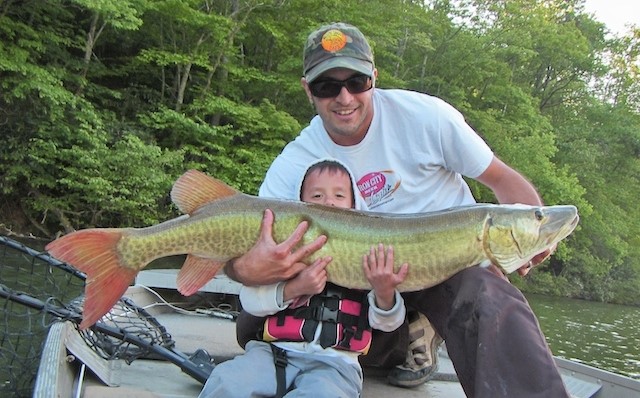
Fisheries biologists from the Virginia Department of Wildlife Resources were excited to have encountered two muskies weighing more than 50 pounds each recently while sampling on the Shenandoah River.
If you’re out on the water in pursuit of the “fish of a thousand casts,” please consider contributing to DWR’s Musky Angler Diary Program, new for 2021. Participating in this program is a helpful tool for biologists in managing and refining muskellunge fisheries. The process is easy. Simply record how many hours you fish, how many persons are in your fishing party, how many musky you encounter but did not catch (follows, strikes, or musky lost), how many musky you did catch (measure them and look for tag numbers), whether or not you harvested or released the musky, and how much money you spent on the trip.
Muskellunge (Esox masquinongy) or musky are the largest members of the pike family. They are normally olive to dark gray on the back with grayish to bluish to yellowish sides. The sides may have faint vertical bars, spots or blotches.
Musky are an exciting and addictive fish to target in the waters of the commonwealth. However, some specialized techniques and equipment are required to hunt for these trophy fish.
River fishermen use rafts, kayaks, canoes, or small boats with electric motors or small outboards to float larger pools and fish near woody debris, large boulders, drop-offs, or weed lines. We suggest using an eight-foot medium heavy rod with fast action and a bait casting reel with a 6.4 gear ratio. Fill the reel with 80-lb. braided line, tipped with an 80-lb. fluorocarbon leader. You can also use a steel leader if you like.
There are many musky baits on the market, but most fall into five categories: inline spinner, crankbait, top water, soft plastic, and jerk baits. For beginners, try using an inline spinner or top water bait. They can be very productive from May through July and are easy to use.
Crank baits and soft plastics are good choices in the fall and winter months when muskies tend to target larger prey items like suckers. Jerk baits are the most challenging to use but can be effective in any season.
Anglers interested in trying to fish with live bait should use large hooks, 4/0 or larger. Some anglers simply allow 8 or 12-inch suckers, shad, or carp to swim free below the boat. Combining this method while casting artificial lures can be very effective.
Muskies are commonly caught in lakes by trolling deep water with large crankbaits, spoons, and inline spinners. Be sure to carry a large net with you as well as long nosed pliers, jaw spreaders, hook cutters, and hook resistant gloves.
Muskies prefer cool, clear lakes with abundant vegetation or long pool areas of rivers near fallen trees and other submerged structures. They prefer water temperatures ranging from 62°F – 75°F. Water temperatures up to 89°F can be stressfully tolerated, but musky stop feeding at 84°F. During the summer musky can be found seeking refuge where the water is cooler. When this behavior is observed, it is recommended to avoid targeting these fish as they are stressed due to warming water temperatures.
In Virginia, Muskies spawn in early spring at the end of March through April when waters reach 50°F to 60°F. Sexual maturity is reached at three to five years of age. Eggs are fertilized by one to three males and broadcast over aquatic vegetation, leaf mats or gravel bottoms in shallow bays and coves of lakes, or in slack pools or backwaters above or below riffles in rivers. Females release 10,000 to 250,000 eggs depending on the size.
Most musky populations in reservoirs are maintained through stocking. Some rivers like the James River and the New River are maintained through natural reproduction.
Musky are not believed to be native to Virginia. The first stocking of Muskellunge occurred in the New River in 1963. Since then more resources were added to the list of stocked waters or occupied by both stocked and self-sustaining populations.
Initially, hatchery musky were imported from New York, Pennsylvania, West Virginia, and Tennessee. Our current stocked muskies are considered advanced fingerlings and range in size from eight to12 inches.
These fish are incredibly challenging and costly to raise. Department of Wildlife Resources staff begin the process of rearing musky in March and April. Biologists and hatchery staff work together to collect both male and female musky from the James River. These brood fish are then shipped to the Vic Thomas hatchery. Brood fish are held for three days and are checked for ripeness. Typically 150,000–200,000 eggs are harvested, fertilized, and shipped to the Buller
Fish Hatchery. Buller hatchery staff monitor the eggs closely until they hatch. Brood fish are then returned to the river from where they were collected.
Once hatched, the musky fry are stocked into ponds at Buller as well as Front Royal Fish Hatchery. The fry feed on plankton, insects, and small minnows. Musky are incredibly carnivorous. If minnows run short, they will cannibalize their brothers and sisters. Hatchery staff continue to monitor the ponds throughout the summer. In the fall the ponds are drained and the fingerling musky are harvested, loaded onto stocking trucks, and distributed to select resources.

